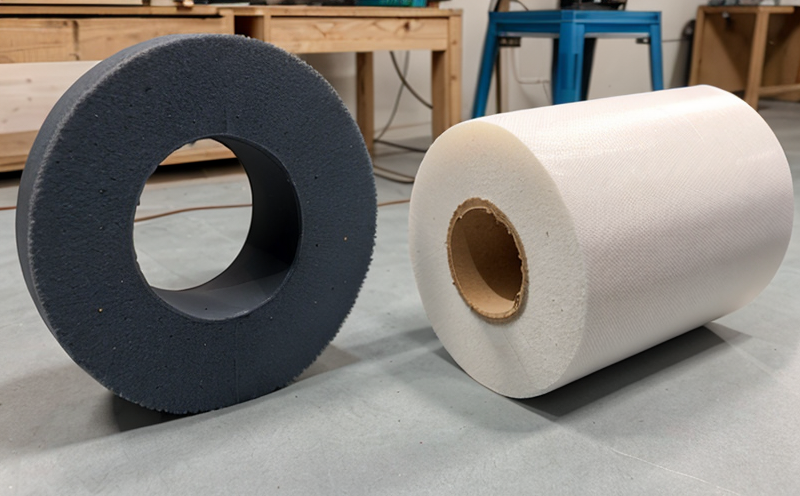ISO 3349 Determination of Modulus of Elasticity in Static Bending of Wood Testing
The determination of modulus of elasticity (MOE) using ISO 3349 is a critical process for quality assurance and compliance within the furniture sector. This method ensures that wood materials used in furniture construction meet the required standards for strength, durability, and structural integrity. The MOE provides insight into how much stress a material can endure before undergoing plastic deformation, which is essential for designing safe and long-lasting furniture.
Wood species exhibit varying mechanical properties depending on their type, moisture content, and age. ISO 3349 allows for the accurate measurement of these properties under controlled conditions, ensuring that manufacturers can select appropriate materials based on performance requirements. This standard is particularly important in sectors where aesthetics and function are balanced, such as high-end furniture manufacturing.
The test involves bending a wood specimen until it reaches its maximum load capacity while measuring the strain at various points along its length. By analyzing these measurements, one can determine the modulus of elasticity, which is crucial for predicting how well a piece of furniture will perform under typical use conditions. This information helps quality managers and compliance officers ensure that products meet regulatory standards and customer expectations.
In addition to providing insights into material performance, ISO 3349 also supports research and development efforts by allowing engineers to optimize design parameters such as thickness and grain orientation. For procurement teams, this standard ensures consistent supply chain quality, reducing the risk of substandard materials being used in production.
The testing process typically begins with selecting an appropriate specimen size and shape that accurately represents the intended use case for the final product. Specimens are then prepared according to ISO 3349 specifications before undergoing static bending tests in a controlled environment. The results are analyzed using advanced software tools, providing detailed reports on material properties.
Understanding the nuances of this testing method is key to maintaining high-quality standards across various applications within the furniture industry. By adhering to international guidelines like ISO 3349, businesses can ensure they are producing safe, durable products that meet both internal and external quality criteria.
Applied Standards
| Standard Number | Description |
|---|---|
| ISO 3349:1998 | Determination of modulus of elasticity in static bending of wood |
| ASTM D1926-07(2020) | Standard test methods for determination of flexural properties of wood and wood-based panels |
| EN 345:2015 | Wood - Determination of modulus of elasticity in static bending of solid timber structural members |
The above standards provide comprehensive guidance on how to perform the determination of modulus of elasticity using ISO 3349. Each standard offers unique insights into different aspects of wood material testing, ensuring that tests are conducted accurately and consistently.
Scope and Methodology
| Aspect | Description |
|---|---|
| Sample Preparation | The sample must be cut from a representative part of the wood specimen, ensuring that it is free from defects. It should also be conditioned to ensure its moisture content aligns with the specified requirements. |
| Bending Test Setup | A standard three-point bending test setup is used where the sample is subjected to a gradually increasing load until failure occurs. Strain gauges are attached at specific intervals along the length of the sample to measure deformation accurately. |
| Data Collection | During the test, data on applied force and corresponding deflection is collected. This information is used to calculate the modulus of elasticity based on the slope of the load-deflection curve. |
The methodology outlined in ISO 3349 ensures precise measurement of wood’s elastic properties under static bending conditions. By following these steps, laboratories can provide reliable data that contribute significantly to product development and quality assurance processes within the furniture sector.
Use Cases and Application Examples
- Furniture Design Optimization: Engineers use MOE values obtained from ISO 3349 tests to refine designs, ensuring they are both aesthetically pleasing and structurally sound.
- Quality Assurance: Furniture manufacturers rely on these tests to verify that their materials meet specified strength requirements before production begins.
- Regulatory Compliance: Compliance officers ensure that all products adhere to relevant national and international standards, including those specified in ISO 3349.
- R&D Innovation: Researchers utilize this method as part of their broader efforts to innovate within the wood science community, contributing to advancements in sustainable materials development.
These examples illustrate just how integral the determination of modulus of elasticity is across multiple facets of the furniture industry. From design and production to regulatory compliance and research innovation, ISO 3349 plays a vital role in maintaining high-quality standards.





